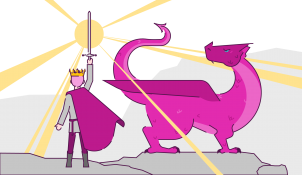Any one of these 13 sales messaging mistakes could be costing you money. From failing to find persuasive messaging, to telling your story in a boring way that makes prospects switch off, to arming sales people with the wrong sales tools – if you make these mistakes, your sales will suffer.
Features and functions
People may well need to know what your solution can do, but remember (i) they probably don’t need all the finer detail (ii) they want to know what your solution can do for them. The best way to talk about features is to use them to justify the claims that you make about benefits.
Selling the solution too early
If your prospect hasn’t been convinced that they should buy a widget at all, there’s no point trying to persuade them that your widget is the best one. First, sell the category (whether to buy this type of thing at all), then sell your solution (which one to buy).
“Let me tell you a bit about our company…”
You may well have 84 locations, a $6.7 billion turnover, and 22,000 employees, 5 divisions, and a share price of $21. Great. So what? If there’s a sales message in there, then bring it out explicitly. If you just like talking about your own company stop, and ask if it’s interesting to listen to.
No repetition
As much as we wish our key sales messages were instantly memorable, they rarely are. Without repetition, they just get forgotten. Got some key messages that really explain why prospects should choose you? Repeat them so they can be remembered.
Any questions?
If you pitch, you need to ask for the business. Try to close, uncover objections, rinse and repeat. It isn’t enough to put up a boring slide with a photo of an audience and ‘Any Questions’ written on it and to hope that the prospect will reveal their thinking. You need to try and take control of the sales process, and to try and advance to the next stage.
No clear next step
Not every sales meeting ends in an order, and nor could they. Sometimes you just want to be given a chance to run a study, start a trial, access the decision-maker, or to be put onto a short-list. These objectives each require different sales messaging, because they each offer their own level of commitment, level of risk, and set of decision-making criteria.
No differentiation
It’s not enough to talk about valuable benefits when your competitors all claim to deliver the same benefits. Does everyone in your market ‘enhance productivity’ or ‘reduce risk’? If so you need to think about (i) what allows you to do these things better (ii) what benefits you offer that others can’t.
False assumptions about competitors
Maybe you are particularly proud of a certain feature. But before you assume that it’s unique – check. There’s nothing that undermines your sales messaging like claiming “we’re the only company who have Feature A’ when your prospect just heard from your competitor that they have it too. Think you would never make this mistake? Maybe, but we’ve seen it before. It’s one reason why it makes sense to interview new hires who just came from competitors.
So what?
Not every point of differentiation is interesting to your prospects. Maybe you are global – but if they only operate in one country, will they care? Maybe you are the oldest company in the market. Does it matter to customers that your competitor is five years younger? Focus on things where you have an advantage and that your prospects care about.
Thrown over the fence
Sales messaging only works if sales people use it. That means (a) involving the sales team in shaping your messaging, in particular learning from their experience with customers (b) cutting the bull, the jargon, and the business-speak (c) understanding the sales cycle so that what gets created actually relates to a particular interaction during the process.
Poor quality sales tools
Sales messaging lives in the tools and sales content that are given to sales people to use. The best messaging that’s then written in text-heavy PowerPoint slides won’t work. Your sales tools need to be easy to use, look great, and use visuals that help prospects “get” what you’re saying.
The wrong star of the story
Who’s the star of your story? Is it your products? Your company? It should be your prospect. Something has changed in the world and your prospect is facing a difficult challenge. They try to overcome the challenge ‘the old way’ but didn’t manage it. They get help (from your company – the Obi-Wan Kenobi figure), and overcome the challenge to enter a better world. It’s a story – but it’s a story about them. Not your company.
‘Show up and throw up’
You have your sales messaging written. You know what you want to say. Great. But you need to tailor your message to your prospect. You don’t decide in advance what you want to say before meeting somebody, and insist on telling them 20 things about yourself without waiting for their response. So why do it in sales? Don’t forget that sales is about conversation, not telling your prospects everything you could possibly say without pausing for breath.
Leave a comment




